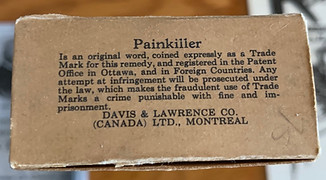
Patent Medicines
Thank You
Patent Medicines were commercialized remedies available over the counter without a prescription.
These medicines or “cure-alls” were given a patent and trademark making the producers able to withhold the ingredients. Patent medicines often contained alcohol and narcotics such as opium and cocaine.
Patent Medicines were often created as “get rich quick” schemes that became successful due to advertising and marketing campaigns.
Many of these remedies had little effectiveness in improving one’s health but their popularity raged on well into the 19th and early 20th centuries.
Many thanks goes to our 2019 Canada Summer Jobs employee Melanie King for her research and curation of the original museum exhibit.

Dr. Wilson’s Herbine Bitters
Circa 1880’s
Also known as “The Great Anti-Bilious Remedy”, Dr. Wilson’s Herbine Bitters claimed it made the blood pure and boasted purgative and laxative properties. Additional uses for this patent medicine included sick headaches, dyspepsia, liver complaints and more.
Advertised as a family medicine, Dr. Wilson’s Herbine Bitters was found to contain alcohol, dandelion, mandrake, and burdock.


Bottle of Wilson's Herbine Bitters
Museum collection
Image Source: www.bottlepickers.com
Radway’s Ready Relief (R.R.R.)
1840’s to 1910’s
Claimed to be the “Universal Remedy”, Radway’s Ready Relief advertised itself as a treatment for rheumatism, neuralgia, sciatica, nervousness, and fever. It allegedly stimulated circulation and relieved muscle pain.
Some of the ingredients included ammonia, camphor, potassium carbonate, oleoresin capsicum (used in pepper spray), castile soap and a whopping 27% alcohol.
In 1914 the company was fined $50 for making false and fraudulent statements. This is equivalent to approximately $1,300 US today.


Box and bottle of Radway's Ready Relief
Museum collection
Image Source: Flickr
Dr. Pierce’s Favorite Prescription
Early 1900’s
Doctor Ray Vaughn Pierce was born in 1840 in New York. He set up a laboratory in Buffalo and began creating several patent medicines including Dr. Pierce’s Favorite Prescription which was marketed towards “the weaker sex”: women.
This patent medicine was said to aid female health problems such as menopause and “female nerves”. Some of the ingredients included:
• Black Cohosh Root – aided digestion, increased appetite, relieved symptoms of menopause, rheumatism, and headaches
• Blue Cohosh Root – encouraged menstruation, reduced uterine inflammation
• Unicorn Root – relieved symptoms of leucorrhoea, menorrhagia, amenorrhoea
• Oregon Grape Root – used as a laxative and diuretic
• Lady’s Slipper Root – relieved irritability and hysteria
The Lady’s Home Journal tried to prove that there were alcohol and opium in Dr. Pierce’s patent medicines but they were inconclusive. As a result, they were forced to pay Dr. Pierce a hefty fine.
Pierce was elected State Senator in 1878 and then elected to the US Congress in 1879. He was forced to resign in 1880 due to poor health and died in 1914 at the age of 73. His son took over the production of the patent medicines into the 1970s.

Image Source: www.stevebisig.com

Bottle of Dr. Pierce's Favorite Prescription
Museum collection
Lydia E. Pinkham’s Vegetable Compound
Circa 1880’s
Lydia Pinkham was born into a Quaker abolitionist family in 1819. After graduating from high school she became a school teacher until 1843 when she married widower, Isaac Pinkham.
Lydia began making home remedies in her kitchen that she would give to family and neighbours. In 1873 after a financial crisis Lydia and her family were almost destitute. Lydia’s son Daniel suggested she start selling her home remedies. In 1876 she patented Lydia E. Pinkham’s Vegetable Compound and formed the Mrs. Lydia Pinkham Medicine Company.
The Vegetable Compound was marketed towards “female complaints” and claimed to relieve menstrual pain and menopause symptoms. Its original ingredients included black cohosh root, unicorn root, and 20% alcohol.
The tag line for the Vegetable Compound was: “There’s a baby in every bottle”.
Lydia E. Pinkham started an advice department where hundreds of letters poured in daily from women seeking health advice from other women as they often felt uncomfortable discussing these issues with male doctors.

Image Source: Marietta Journal Online

Bottle of Lydia E. Pinkham Compound and Box of Lydia E. Pinkham's Tablets
Museum collection
Perry Davis’ Painkiller
1840’s – 1940’s
Perry Davis created his patent medicine compound in 1839 after an illness almost took his life. Davis would peddle his medicine at outdoor markets but soon the demand outgrew his supply. Along with his son, he formed the company Davis & Son and started selling his elixir in mass quantities.
This remedy was used to relieve chills, cramps, colic, sore throat, sprains, bruises, and chilblains among other ailments. Some of the ingredients contained in the medicine included camphor, vegetable compounds, opiates, and ethyl alcohol.
Perry Davis went to court in an attempt to trademark the term “painkiller”. The term became too generic and Davis lost his trademark for the term.

Image Source: www.rdhinstl.com


Box of Perry Davis' Painkiller
Museum collection
Disclaimer on the top of the box that the term "painkiller" was trademarked
